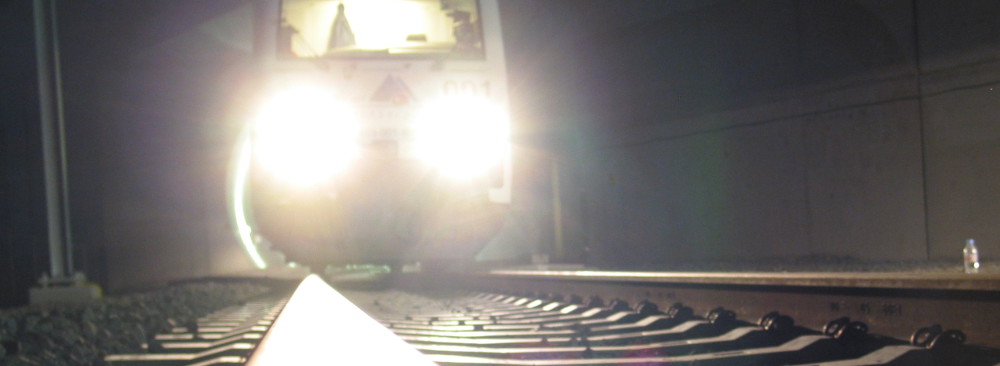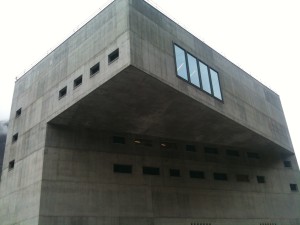I work as a test lead for the automatic train protection system in the Gotthard Base Tunnel. The company is called Thales Rail Signalling Solutions AG. Thales is in a consortium of Transtec Gotthard, which, on behalf of AlpTransit Gotthard AG equips the Gotthard Base Tunnel with technology. Since December 2013 tests take place. I have led several tests with test drives. Below you find my review of experiment operation Faido-Bodio-West.
On the day before the first electric drive our team travelled to Biasca. The connection between a locomotive and the Radio Block Centre RBC in Bodio we had tested a few days earlier from Zurich. So, we knew that the connection would basically work. Some uncertainties were still there; we would use another locomotive and another radio cell as pretested in Zurich. Since the tests in Lötschberg Base Tunnel in 2007, I did not do any field testing, this is why I was a bit nervous. We arrived early at the briefing, where we did a walkthrough of the planned tests.
First, the electric engine had to be pushed in the tunnel by a diesel locomotive. This is because outside of the tunnel is no catenary available.
Then an orientation tour is planned so that we all can make us familiar with the test track Faido-Bodio-West. Then would take place some tests in which the field data points, also called balises, are approached; This is in order to calibrate the locomotives odometer and also to see the signals in form of marker boards.
At speeds above 160km/h the signals are transmitted by radio to the cab. To supervise the distance to the red signal, the odometer counts down the distance. This test is called “conformity check”; it reveals, whether field elements match the plan and indoor equipment.
The briefing was led by the dispatcher from Bellinzona. After the attendance check he calls me. I should explain the script in detail. Somewhat surprised, I explained the conformity check step by step. Then the roles of all participants are discussed. It is announced which role speaks with whom and who not, to improve safety at the maximum.
After the briefing we go to the train, the dispatcher and the colleagues go to the new “operations center south” of the SBB. The little train, consisting of locomotive and the diesel are made ready to drive. The train driver asks the operations center for setting the points, so that we can drive to the portal of the tunnel. The atmosphere on the locomotive is friendly, but a little tense, because no one knows whether the checks will work.
We’re disconnected a few hundred meters after the portal. The diesel drives away, we move the pantograph up. Previously, no electric locomotive used the power here. In fact, the voltmeter shows 15’000V voltage. We can drive! The dispatcher gives his confirmation and we move slowly but delighted in front of the first marker board. Then I ask that the dispatcher to set routes for the orientation drive. We now turn the onboard unit with the train protection ETCS on.
When the train starts up again, it connects directly to the RBC. After 10 seconds, the connection to the RBC is hung up. I’ve a presentiment. Presumably, the locomotive connects to the last selected RBC – and that can really only be the RBC of Mattstetten-Rothrist in Olten. We check the stored telephone number of the RBC, and it is actually the telephone number of RBC in Olten stored.
We’re changing this to the number of the RBC Gotthard. The onboard unit connects again, now the connection remains stable. The Gotthard RBC likes us better. The dispatcher gives his conformation to drive and we go in the Mode StaffResponsible, where the train driver bears the responsibility for the safety of the train.
100 meters in front of us we find the first data stones, also called balises. On the balises the RBC gives us, via radio, a movement authority in the mode full supervision! The Joy is huge. It works! After asking back the dispatcher it is confirmed that the signals are green. This means, then, that a route is set and the RBC is in full responsibility for the train protection. With 40km/h we travel the 15-kilometer route. At the end, we get out of the locomotive. Meanwhile, all have taken off their jackets. On the Portal, it was windy 2°C, here we can walk around in the T-Shirts. Screaming of joy and clapping echoed through the tunnel. All tension is gone, the mood is relaxed. There are souvenir photos shot on this memorable first trip, in which the system has worked flawlessly. The return trip we drive with a speed of 80km/h.
For the outward journey I check the tunnel-mounted marker boards. It’s all set up properly, the balieses work – we do not get an emergency brake. So I know of the laboratory that the following checks are going to work, as well as the numerous drives planned in the next few weeks. This is a big relief, because the four years of preparation in the laboratory in Zurich have yet fully paid out. After a short pause we proceeded with the conformity check, more data points to be examined. The eight hours pass by quickly. Then we have to order the diesel to pick us up near the portal. Back at the debriefing will be warmly welcomed. We shake all the Hands. At the same time, a first electric drive and a first trip with RBC – and yet successful – has never been done before.
Summary of the experiment operation
On 13.06.2014 the six-month experiment operation ended in the southern part of the West tube between Faido and Bodio. The different tests could reach their goals. At the level of the technical requirements, it should have been shown that all installed systems basically work together. From a perspective of rail operations, the new, for the Gotthard defined processes, particularly in the incident management, were demonstrated. With a view to the final commissioning in 2016, should be demonstrated that the sections approach, to design and test, is fit to the overall system. For Thales, it was particularly also about showing that the lab results are transferable to the field.
To achieve these objectives we tested for 78 days 7109 km in 664 single trips. Thales had 10 days to test exclusively, which resulted in 142 runs. These numbers could give a picture of the drives we’ve done but never would explain how intense the software testing was.
In retrospect, the testing was very intensive and in the end, also successful. All parties have gained a lot of experience and knowledge. The delivered train protection system has met the expectations. We were able to show that the software behaved in the field the same as we knew it from the lab. The basic functions were all available and could be shown in the operational processes.
It was interesting for us to make experiences together with the operator SBB. The processes on the locomotive, manoeuvre of the vehicle between the two tests, the exact position of the vehicle to start the test and how the vehicle got there – all of this has an impact on the subsequent test drive, we learned.
Extremely helpful were the many contacts and insights into the work of the other teams from Alp Transit Gotthard, the SBB, as well as the monitoring of the Federal Office of Transport FOT. Finally, there was a broad interest of Public, visitors from politics and the media, as well as various contributions in Television programs and magazines.
The experiment operation has helped to expand the horizon on a complex system as a whole, with a variety of stakeholders with different expectations and perspectives. This complements our laboratory tests in Zurich. It also helps us planning and optimizing the further commissioning installation sections. It shows that we are well prepared for the test operation that starts in October 2015.

